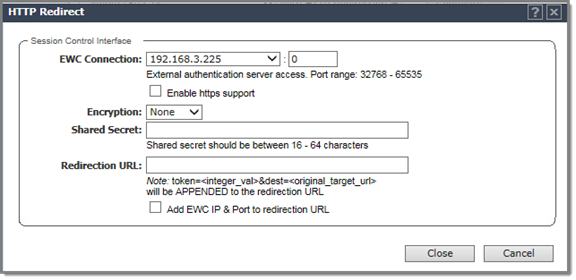
External Captive Portal Page - Fields and Buttons
| Field/Button | Description |
|---|---|
| Session Control Interface | |
| EWC Connection | In the drop-down list, click the IP address of the external
Web server. and then enter the port of the controller. If there is an authentication server configured for this VNS, the external Captive Portal page on the external authentication server will send the request back to the controller to allow the controller to continue with the RADIUS authentication and filtering. |
| Enable HTTPS support | Select Enable https support if you want to enable HTTPS support (TLS/SSL) for this external captive portal. This has no impact on the traffic exchanged between users‘ browsers and the External Captive Portal. When enabled, this option protects the session control traffic between the external captive portal and the controller from being read by a third party. This is particularly useful when a dedicated network management VLAN is unavailable to carry the session control traffic. For more information, see the Integration Guide. |
| Encryption | Select the data encryption to use. Options are:
Note: Using the encryption option has one advantage over using the HTTPS option
alone. When HTTPS is enabled, the ECP can authenticate the controller‘s
certificate, but the controller does not ask the client to provide one.
Consequently, HTTPS does not prevent unauthorized users from sending messages to
the session control interface. Because the encryption option is based on a shared
key, the encryption provides a form of authentication. If the controller can
decrypt the payload of a session control message, then it is has reason to believe
the message came from the external captive portal.
|
| Shared Secret | Type the password common to both the controller and the external web server if you want to encrypt the information passed between the controller and the external web server. If encryption is enabled then a shared key must be entered. A shared key is a string that both the controller and the ECP use to encrypt and decrypt session control messages. The shared key must be between 16 and 64 characters long. For better security, use a long key composed of randomly selected characters. |
| Redirection URL |
The Redirection URL field contains the URL to which the controller will
redirect all blocked, unauthenticated HTTP traffic on this WLAN Service, or traffic that has been explicitly configured for
redirection, depending on your configuration. This should be the URL of the page that
will prompt the user to authenticate. If using host name rules, the redirection url
can be the configured host name. The redirected browser will issue a “get” to
the ECP for this URL. The “Redirection URL”:
Note: The Redirection URL does not support IPv6.
|
| Add EWC IP & Port to redirection URL |
The Add HWC IP & Port to redirection URL option is useful if the external captive portal serves more than one controller. An ECP must send its session control messages to the controller hosting the controlled session. If an ECP serves more than one controller, then the Add HWC IP & Port to redirection URL option must be used to identify the source of the redirection. The ECP should store the controller address and port with the token and other session details so that it is available throughout the authentication process. |
| Special | |
| ToS override for NAC | Allows for ToS marking results in redirection to a captive portal via a NAC server. |
| Close | Click to save your changes and close this page. |
| Cancel | Click to discard the configuration |

Note
You must add a role rule to the non-authenticated filter that allows access to the external Captive Portal site. For more information, see Policy Rules.